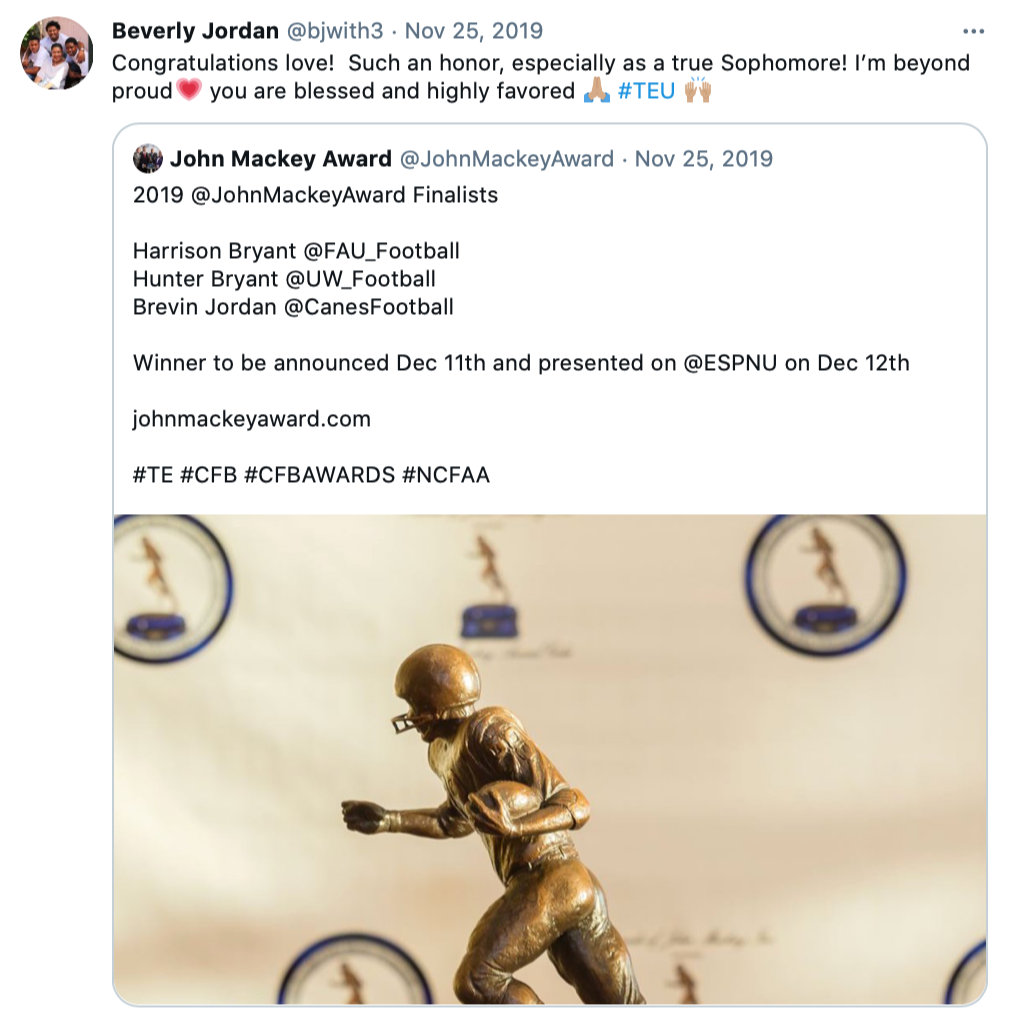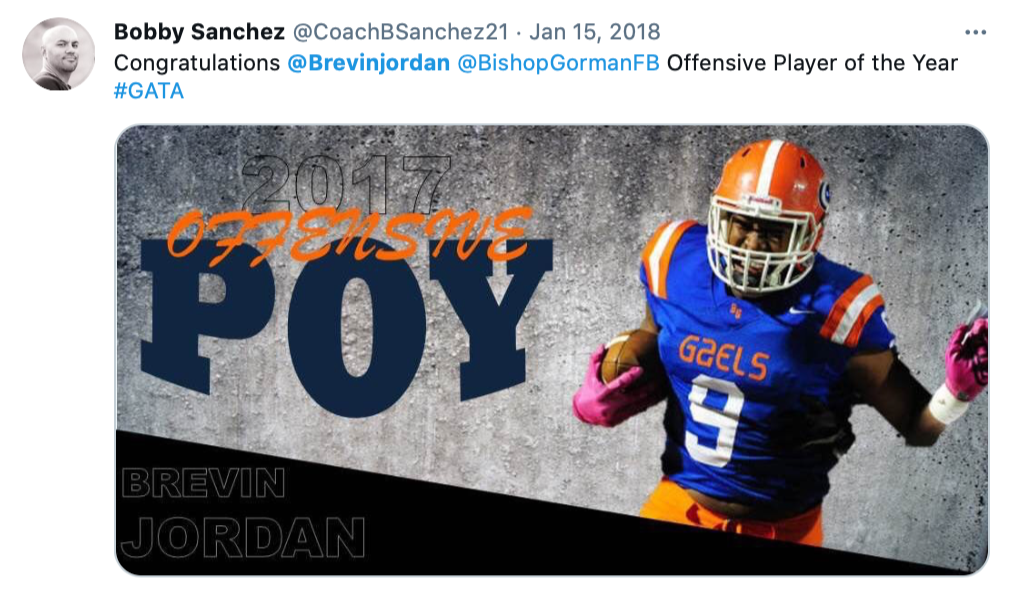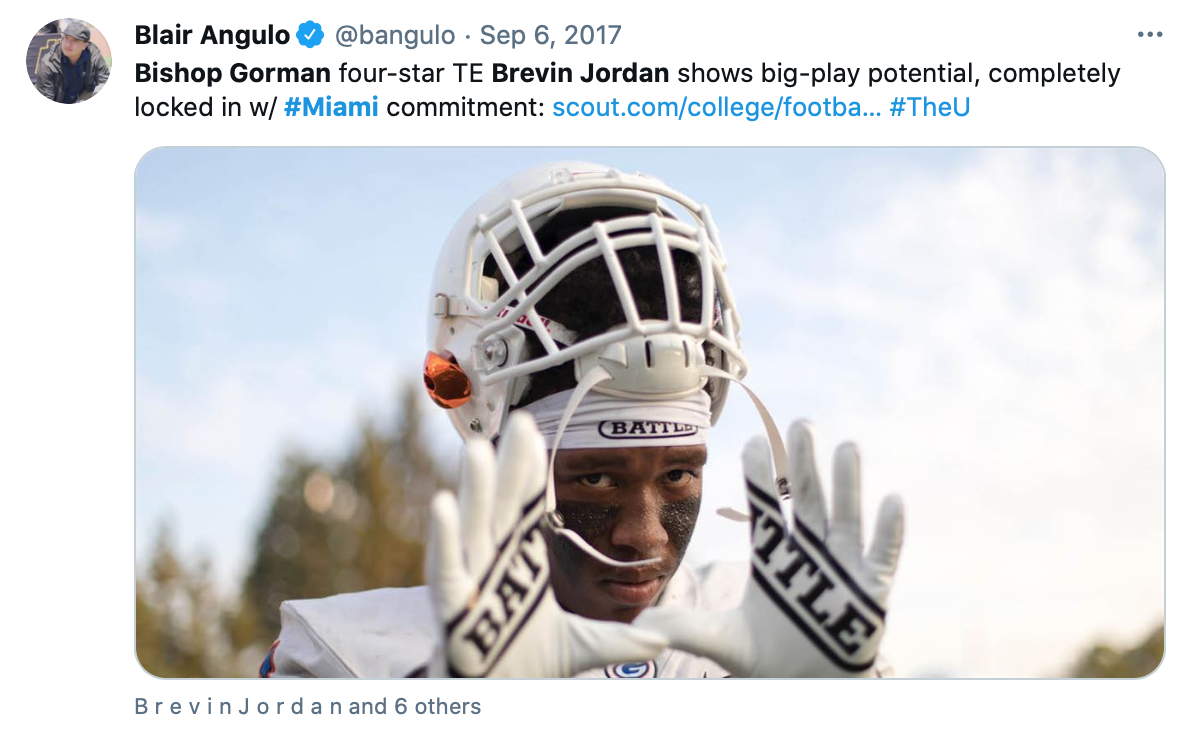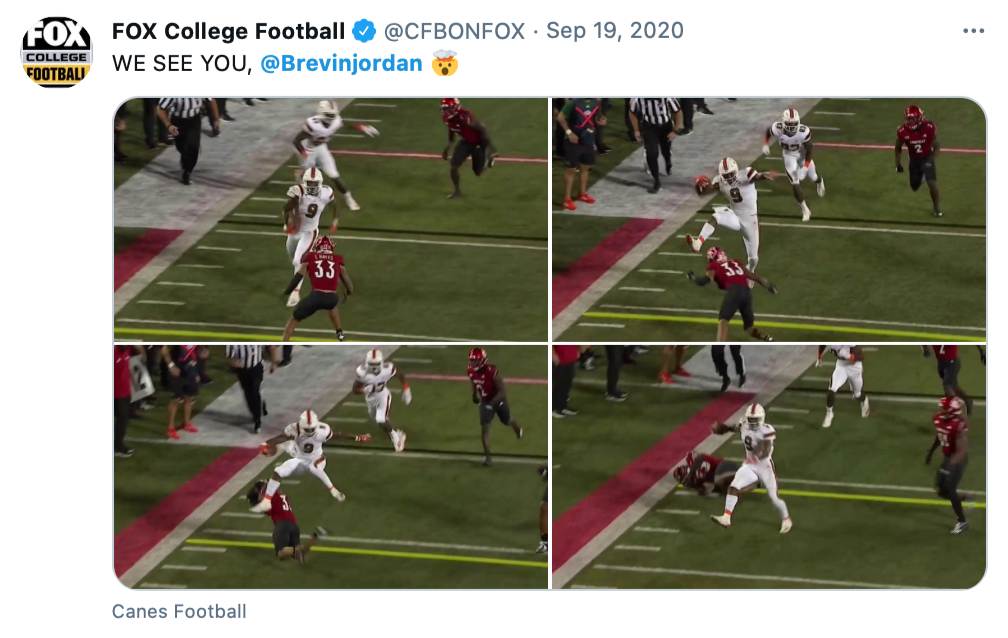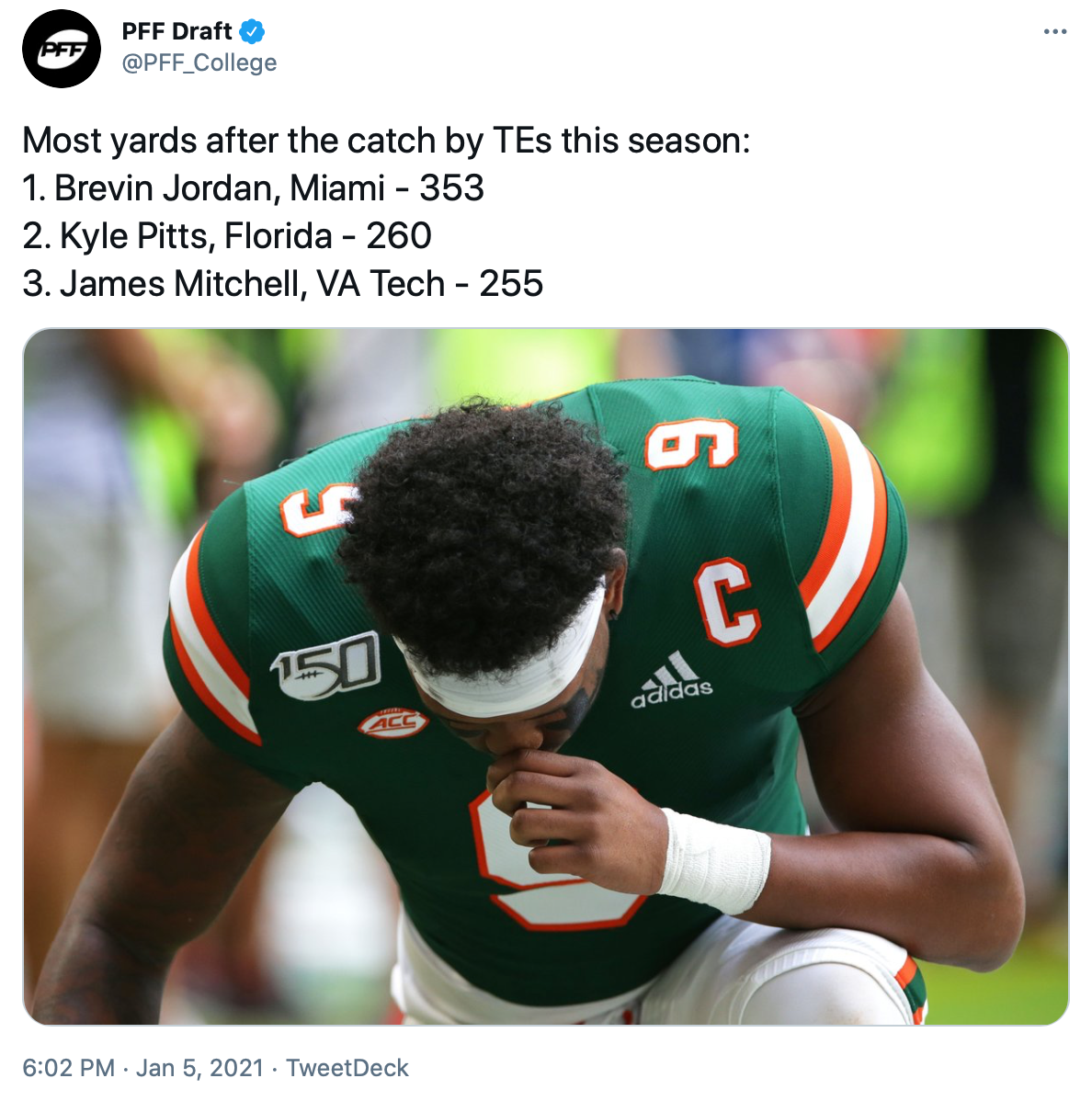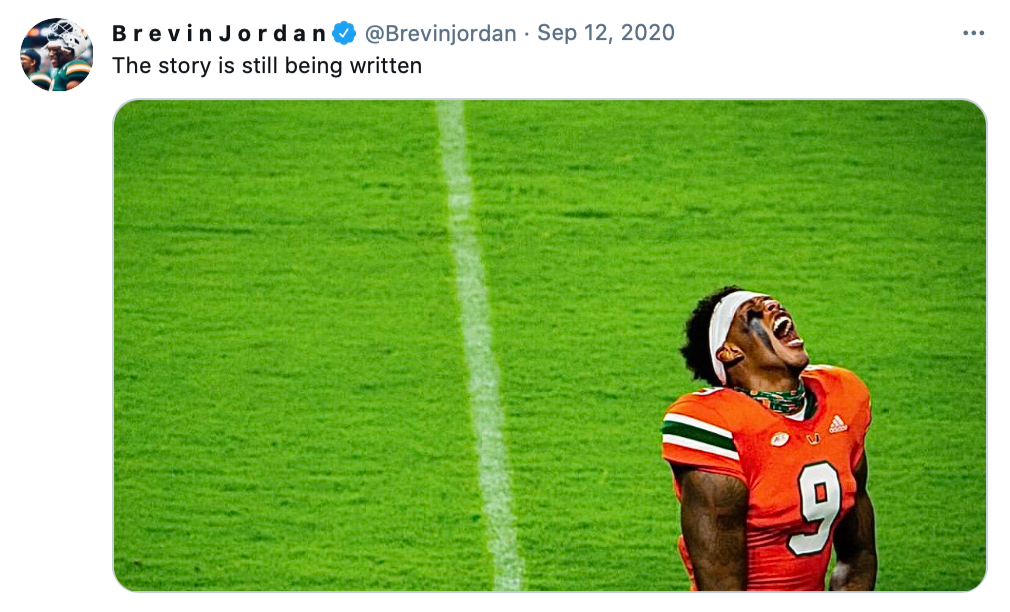Brevin Jordan
TE | Miami Hurricanes | 6-3 | 245 lbs.
Rookie Expectations
Rookie receivers, in general, have expectations they must satisfy during their opening season in order to see significant time on offense. Over the last three NFL seasons, rookie tight ends have averaged to run five particular patterns that account for nearly 80% of total routes. Those five routes include Crossers, Outs, Flat work, Hitches, and Gos. Crossing routes — on which receivers will intentionally cross midfield — easily stand as the most frequent, important route at the position. On average, rookie TEs will run a Crosser on nearly a fourth of all routes. To put that into perspective, rookie TEs will be asked to run Posts, Corners, Ins, and Slants on less than 20% of total routes, combined. Whenever I make references to “NFL routes” in these Dyno rookie profiles, those are the guidelines I am following.
The Story
Brevin Jordan’s story is one born of tragedy, overcome by strength. Brevin’s father, Darrell Jordan, played linebacker in college at West Texas A&M (1985-86) and Northern Arizona (1988-89). He was drafted in the ninth round of the 1990 draft by the Atlanta Falcons under the Jerry Glanville regime. Darrell would never play an official down for DC Doug Shively since a shoulder injury suffered during a preseason game ended his career. His parents separated when Brevin was very young. As he was raised by his mother, Beverly, his father never nudged him nor his older brother, O’Shay Jordan, toward football. But when the Jordan brothers found some of their father’s football paraphernalia, they were immediately drawn toward the game.
Prior to that discovery, their mother, Beverly, was diagnosed with Stage 3 breast cancer when Brevin was only four. When the disease spread to her liver, doctors told her she wouldn’t have long to live. The news did nothing to stop that proud mother of three young boys. Beverly overcame her cancer, supporting her son to this day.
One year after the diagnosis, the Jordan boys got their first taste of the game. O’Shay and Brevin wanted to play together so badly that Brevin would play in the 8-year-old division as a five-year-old. His early days on the field would be played at LB. He made the switch to RB when he finally began playing with kids his own age, when he was eight.
Jordan played at RB until he joined the football team at Bishop Gorman High School, his father’s former school. Prior to his arrival, former head coach of the Gaels, Tony Sanchez, departed to take on the same role at UNLV. He was succeeded by his younger brother, Kenny Sanchez. During Jordan’s freshman year, Sanchez would convince Brevin to make the move to TE. Since Jordan had his heart set on converting to WR, he initially resisted the advice. By his sophomore season, Jordan’s TE roots took hold, and he moved up to the varsity squad. Over his three seasons on the varsity roster, each would end in state and national championships for Bishop Gorman… with a 43-2 overall record.
During his Age 15 season as a junior, Jordan collected 27 receptions, 501 yards, and nine TDs with Tate Martell under center. One Hudl play in particular (1:15) from that junior season stands out as showcasing Jordan’s work after contact, a direct benefit from his time as a RB. When we look at his college tape, you’ll see countless similar examples. At the end of his senior season, Jordan’s numbers would improve with Dorian Thompson-Robinson at QB to 63 receptions, 1,111 yards, and 16 total TDs. For the fantasy degenerates out there, Jordan averaged 18.4 FPG as a 16-year-old youth playing for, at the time, the top school in the nation. Needless to say, Jordan would have his pick from collegiate football programs across the United States. ESPN and 247Sports headlined him as their TE1, with Rivals slotting him in as their TE2.
Jordan would commit to the Miami Hurricanes after his junior season under then HC Mark Richt. He made the decision based on their storied identity as “TE U” after guiding a long list of talented TEs toward claiming productive NFL careers. Just when his career was on the brink of gaining national attention, Brevin’s father passed away in 2018 at the age of 51 from a heart attack. He died two months after watching his son aid Bishop Gorman in winning its third Nevada state, national championship, and seven months before Brevin would play his first snap for the Hurricanes.
The Attributes
The 2018 class of TEs entering NCAA football was stacked wall-to-wall with premier talent. In addition to Jordan, you had Kyle Pitts, Pat Freiermuth, and Tommy Tremble, who will each be selected in the 2021 NFL Draft. Then you had Jeremy Ruckert, Josh Whyle, James Mitchell, Braden Galloway, Spencer Webb, and Trey McBride who have eligibility remaining (and also bright NFL futures).
Jordan set out to further distinguish himself from that loaded class at The Opening Regional in the summer of 2017. He was timed in the 40-yard dash at 4.78 seconds, short shuttle at 4.21 seconds, and with a vertical jump measurement of 27.9 inches at 6’2”, 224 pounds. That’s not quite matching the athletic profiles of Pitts, Ruckert, or Tremble, but not that far off.
We’ll begin our film review of Jordan during his true freshman season. Keep in mind, short of listing a multitude of links from the full-game footage actually available, using these highlight reels will never offer us the lowlights. We’re lucky to see any blocking — what is shown of the receiving work is usually only compiled of splash plays.
However, I have taken the time to view that footage in order to provide you with my insights. During Jordan’s first season in Coral Gables, his run-blocking push was nonexistent. Not to worry: as a four-star prospect, Jordan would have no shortage of on-the-job training under new HC Manny Diaz, co-OCs Thomas Brown, Ron Dugans, and TE coach Todd Hartley.
On over 300 routes, Jordan would average less than a yard per pattern from an attached alignment. The footage does show us his sexiest inline results at 0:48, 1:02, 2:42, 3:07, and 5:14. Jordan would gain nearly half of his receiving yardage and three-of-four TDs facing Savannah State (7/52/2), and FIU (5/67/1). With those numbers in mind, it should come as little surprise that we don’t see Jordan facing Power 5 competition until 3:07 into the 5:58 video. A slight formation variant to inline is the H-back, stationed off the line of scrimmage. Three examples of Jordan at H-back, running Speed Outs (Flat work) can be found at 2:16, 4:05, and 4:50.
One aspect of the “Korean Air Jordan’s” game — that’s a nickname handed down by his mother — where I feel he was underutilized was as a receiver out of the backfield. I’ll touch more on that later, but we see the sole example from this reel at the 5:45 mark on a designed screen opposed by Virginia Tech’s Cover 2-Man scheme. The remaining work on the video has Jordan in the slot. His slot work would be where his most impressive results would be earned. And he was most lethal when facing Man coverage. Examples from the slot facing Man can be found at 0:12 (Slant), 0:25 (designed screen), 3:19 (Speed Out), 4:39 (Slant), and 5:31 (scramble drill).
Another unfortunate result of viewing this highlight reel is that it only shows Jordan on the routes where he was actually targeted, catching the ball from the slot against zone coverage. With the middle of the field open, defended by Cover 2, 4, and 6, Jordan averaged less than a yard on nearly half of his total routes. But you can view the plays with positive results at 0:00 (Slant), 1:38 (Whip-In), 3:56 (Out), and designed screens at 1:51 and 2:04. When facing Cover 3 on a quarter of his routes, Jordan appeared to be especially lost. His two receptions shown opposed by Cover 3 are at 0:36 (Out), and at 3:40 (designed screen).
As you may have noticed, much of his true freshman production was gained on designed screens (Flat work). It was an area where he also thrived at Bishop Gorman. The downside of his route profile after his opening season was the complete lack of results from Crossers and Outs. He also ran vertical patterns on over 15% of routes of 20-plus yards, only tracking down a single target.
Jumping ahead to his true sophomore season in 2019, since no other footage exists, we’ll use this video. Now that I’ve detailed out the pros and cons from his first season on campus, I’ll separate out the plays a bit differently to highlight important changes. The major changes to Miami’s coaching staff was Rhett Lashlee at OC and, especially important for Jordan, Stephen Field taking over the TE coaching. The results were nothing less than phenomenal for Jordan’s game. His per-route production attached inline to the O-line increased by 69%! We see examples on a designed screen at 2:52 (Man), Speed Out at 3:06 (Cover 3), and down the seam at 0:51 (Cover 4).
Jordan not only carried over his impressive slot production from ‘18, he improved on it by 41%. He’s shown on a Slant at 0:57 (Cover 2-Man), on a fake-screen blockthrough at 2:19 (Cover 2-Man), a Slot Wheel at 2:29 (Cover 4), and on a Speed Out at 3:27 (Man). His biggest improvement was found on Crossing routes. His yards/route run (YPRR) improved by a massive 81%! The footage only offers two examples: 0:41 and 4:07, both stationed inline, and facing Cover 4.
Another massive, much-needed area of improvement was against Cover 3 with the middle of the field closed. His YPRR would spike by 80% over his true freshman results. We can see for ourselves on an In route from the slot at 3:16, and on Speed Outs at 0:15 from H-back and 3:48 from the slot. As previously mentioned, Jordan’s infrequent work out of the backfield continued to prove impressive, to say the least. A couple examples facing Cover 3, no less, can be seen on Flares at 1:26 and 1:34. Over his career, Jordan would average over 5.00 yards/route as a receiver out of the backfield.
His ability to find the holes in Cover 2, 4, and 6 with the middle of the field open also developed. His YPRR facing those schemes improved by 58%. However, we aren’t given any Cover 2 examples in the footage. The detail that immediately stands out in the opening clip of the video (0:00) is the additional burst. He darts out of the slot on the Speed Out against Florida’s Cover 4. We have two other plays with Jordan in the Slot facing Cover 4 at 1:06 (Speed Out) and 1:14 (Seam). To close out these improvements, we see him darting down the seam from inline at 0:25 against Cover 6.
The final improvement to Jordan’s sophomore campaign was sparked by play action. At 1:40 and 1:51 from H-back, Seam routes facing Cover 4 display his growing understanding of secondary manipulation. Then we see him doing his usual work on a designed screen at 2:00 facing Cover 3. At 2:10 on a Corner route (H-back) and 2:44 on another Speed Out (Slot), Jordan uses the Play Action manipulation to shed his Man coverage. In total, his YPRR would jump by 55% with Play Action in Year 2.
For Jordan’s final college season, we’ll utilize this highlight reel. After the impressive improvements from the previous season, Jordan would need some help to continue those results. He got just that when D’Eriq King transferred in from Houston to pepper him with targets. Jordan made some additional gains on the Outs where he was actually tasked to run. We see two of those at 0:52 (Man) and 3:47 (Cover 4) from the slot. One important route from his profile that had mostly been missing was the Hitch/Dig. With King under center, Jordan would put in some impressive work on Hitches (4:17, 4:25, and 7:23).
Man coverage continued to be a welcomed sight for Jordan. His YPRR increased during his final season at “The U” by 19%. Much of that production facing Man was shown in the footage with Jordan at H-back on Slides to the right. We have specific examples at 0:27, 1:18, 4:59, and 5:43. Unfortunately for Jordan, the Cover 3 gains he gave us in 2019 were cut in half with a 45% decrease in YPRR. However, he made continued strides with the middle of the field open. We have the pleasure of a rare Cover 2 example at 3:21. It’s also one of the best exhibits of Jordan showing us he’s begun to understand how to attack an open middle of the field.
We also have a trio of clips with Jordan vs. Cover 4: an impressive hurdle (shown above) before reaching the end zone at 1:41 (designed screen), 3:56 (Slide right), and 5:10 (Post). And another threesome facing North Carolina’s Cover 6 with the Tar Heels holding a considerable lead at 6:12, 6:22, and 6:42. The TD off the Post at 6:42 is a bit comical. Yes, it’s a 76-yard TD. But, considering the Hurricanes were losing by 31 points, a multitude of replays of the sequence were a bit over the top. Those 76 yards would account for 13% of Jordan’s season total.
Fantasy Fit
Several NFL franchises — including Kansas City, San Francisco, and New England — have been in contact with Jordan. As a native of Nevada, he’s expressed how much he would love to have the opportunity to play for the Raiders. But it is far too early to make any sense of these reports. The first order of business will be his Pro Day on March 29. One of the questions that he will most definitely be asked is concerning his injury history. Despite never suffering a significant injury, Jordan managed to miss seven out of a possible 38 games (18%). Forget about injury-prone labels, we need to know why he’s missed so much action due to soft tissue ailments.
After we have that explanation, we will need to face the realization that, despite what he may like to pass along in interviews, he has no business running routes out wide. He also has a checkered history of production running inline routes. He did show enough persistence in run blocking to see that role place him on an NFL field for additional snaps. Jordan’s best asset is his arsenal of weapons working after the catch. No matter what type of fantasy impact he makes, he will always be able to fall back on that ability to extend his career.
All told, Jordan is going to do his receiving work as a Move/Joker TE, running the majority of his routes from the slot. Obvious at this point, I’d also like to see more backfield work from the kid. What concerns me more than anything is his delayed development attacking zone coverages. If he is unable to refine those zone recognition skills into a strength, we’ll only see Jordan on the field for well under 50 percent of snaps. That would be a problem.
The Bottom Line
The path to the truth is always my ultimate goal — don’t hype undeservedly, don’t knock without cause. Fantasy draft profiling is worthless if every player is either legit or a dud. Even though fantasy headlines carry miniscule weight onto real life football, I feel everyone should be accountable for every word in the media. Athletes have families. Athlete’s families tend to read more reports about them than most realize. That’s precisely the reason I spend a good amount of time digging into the backgrounds on these prospects. The goal is not to make you feel sorry for them or their families, it’s to understand their psychological profile. The majority of the kids that are selected in the 2021 NFL Draft currently live inside the body of a grown man, with the psychological development of a teenager.
For Jordan, his path to the NFL has certainly had its ups and downs. At times, he was universally considered the cream of the TE crop. At others, he was plagued by “minor” soft tissue injuries that forced him to miss a fifth of his total games. Allow me to be upfront, I strongly believe hidden forces such as morale and momentum, unquantifiable by numbers, play a major role in football results. I mention that in order to point the spotlight on one of Jordan’s best traits: his passion. Jordan personally provided us with an example here:
This kid is driven. You can see it in his run blocking. As a true freshman, he gave no indication of technique. Still, he never hesitated to get his hands dirty. Following his breakout sophomore season, one NFC South scout even passed along the opinion that “he has no idea what he's doing as a run blocker.” Run blocking is an art form, no question. In order to dig yourself out of the weeds toward a refined approach, players must show the willingness to get in the faces of the dirtiest defenders in the league. I feel Jordan has shown that disposition. Time will decide if Jordan possesses the perseverance to mold his blocking into an art.
Unfortunately, outside of adding additional snaps on Play Action/RPOs, blocking snaps are not going to score us any fantasy points. Jordan possesses more real life football upside than in the fantasy realm. In my best case scenario, Jordan develops into an Aaron Hernandez-type of player. Slightly undersized for the position, utilizing plus athleticism to excel after-the-catch, and excelling on a short-stemmed route profile. In the worst case, he is never able to overcome his zone deficiencies, ending up as the younger version of Dwayne Allen.
There’s just too much uncertainty going into the early years of his NFL career to get me very excited. I would not argue against a late-round selection of Jordan in rookie drafts. In fact, if he slips in your draft, make sure you scoop him up. But it would need to be after Kyle Pitts (obviously), Pat Freiermuth, and Hunter Long are off the board. I really don’t like blindly rolling the dice with my early rookie draft capital. For these reasons, chances are I will end up with limited stock in Jordan. As for further down the road, Jordan holds the potential to do something at the next level if everything falls into place.


